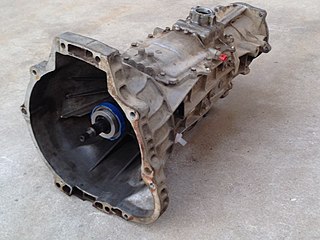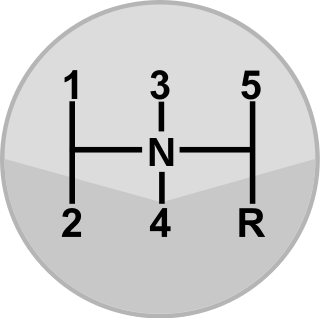
An automatic transmission is a multi-speed transmission used in motor vehicles that does not require any input from the driver to change forward gears under normal driving conditions.

A transmission is a mechanical device which uses gears to change the speed or direction of rotation in a machine. Many transmissions have multiple gear ratios, but there are also transmissions that use a single fixed gear ratio.

A manual transmission (MT), also known as manual gearbox, standard transmission, or stick shift, is a multi-speed motor vehicle transmission system, where gear changes require the driver to manually select the gears by operating a gear stick and clutch.

A parking pawl is a device fitted to a motor vehicle's automatic transmission that locks up the transmission when the transmission shift lever selector is placed in the Park position. "Park" is the first position of the lever in all cars sold in the United States since 1965 through SAE J915, and in most other vehicles worldwide.

In mechanical or automotive engineering, a freewheel or overrunning clutch is a device in a transmission that disengages the driveshaft from the driven shaft when the driven shaft rotates faster than the driveshaft. An overdrive is sometimes mistakenly called a freewheel, but is otherwise unrelated.
A semi-automatic transmission is a multiple-speed transmission where part of its operation is automated, but the driver's input is still required to launch the vehicle from a standstill and to manually change gears. Semi-automatic transmissions were almost exclusively used in motorcycles and are based on conventional manual transmissions or sequential manual transmissions, but use an automatic clutch system. But some semi-automatic transmissions have also been based on standard hydraulic automatic transmissions with torque converters and planetary gearsets.

Drive by wire or DbW technology in the automotive industry is the use of electrical or electro-mechanical systems for performing vehicle functions traditionally achieved by mechanical linkages. Common examples include power steering, electronic throttle control and brake-by-wire. These technologies replace the traditional mechanical control systems with electronic control systems using electromechanical actuators and human–machine interfaces such as pedal and steering feel emulators. Components such as the steering column, intermediate shafts, pumps, hoses, belts, coolers and vacuum servos and master cylinders are eliminated from the vehicle. This is similar to the fly-by-wire systems used widely in the aviation industry. Safety standards for drive-by-wire are specified by the ISO 26262 standard level D.

Hydramatic is an automatic transmission developed by both General Motors' Cadillac and Oldsmobile divisions. Introduced in 1939 for the 1940 model year vehicles, the Hydramatic was the first mass-produced fully-automatic transmission developed for passenger automobile use.

TorqueFlite is the trademarked name of Chrysler Corporation's automatic transmissions, starting with the three-speed unit introduced late in the 1956 model year as a successor to Chrysler's two-speed PowerFlite. In the 1990s, the TorqueFlite name was dropped in favor of alphanumeric designations, although the latest Chrysler eight-speed automatic transmission has revived the name.
Ford-O-Matic was the first automatic transmission widely used by Ford Motor Company. It was designed by the Warner Gear division of Borg Warner Corporation and introduced in 1951 model year cars, and was called the Merc-O-Matic when installed in Mercury branded cars and Turbo-Drive when installed in Lincoln branded cars. In contrast to Detroit Gear Division's three band automatic originally designed for Studebaker which became superseded by this unit, a variation of Warner Gear's three-speed unit named Ford-O-Matic continued to evolve later into Cruise-O-Matic named transmissions in 1958 and finally the FMX named transmissions in 1968. This line continued in production until 1980, when the AOD was introduced. Like Ford, variations of this same Borg Warner design were used by other automobile manufacturers as well, such as AMC, International Harvester, Studebaker, Volvo and Jaguar, each of them having the necessary unique adaptations required for the individual applications.

The automated manual transmission (AMT) is a type of transmission for motor vehicles. It is essentially a conventional manual transmission equipped with automatic actuation to operate the clutch and/or shift gears.
The AXOD was a 4-speed automatic transaxle for transverse front wheel drive automobiles from the Ford Motor Company. It was introduced in the 1986 Ford Taurus/Mercury Sable. The AXOD and its successors are built in Ford's Van Dyke Transmission plant in Sterling Heights, Michigan. Production of the final member of the family, the 4F50N, ended in November 2006.
The Ultradrive is an automatic transmission manufactured by Chrysler beginning in the 1989 model year.
Teletouch is the trade name for the transmission controls found on many Edsel brand automobiles manufactured by the Edsel and Mercury-Edsel-Lincoln (M-E-L) Divisions of the Ford Motor Company. The significance of the Teletouch systems lies in its conception, design and symbolism for American automobiles produced in the 1950s, and the gadgets designed into them. The main distinguishing feature of the system was its use of push buttons on the steering wheel to shift gears as opposed to a gear stick.

A gear stick, gear lever, gearshift or shifter, more formally known as a transmission lever, is a metal lever attached to the transmission of an automobile. The term gear stick mostly refers to the shift lever of a manual transmission, while in an automatic transmission, a similar lever is known as a gear selector. A gear stick will normally be used to change gear whilst depressing the clutch pedal with the left foot to disengage the engine from the drivetrain and wheels. Automatic transmission vehicles, including hydraulic automatic transmissions, automated manual and older semi-automatic transmissions, like VW Autostick, and those with continuously variable transmissions, do not require a physical clutch pedal.

Chevrolet Corvair Powerglide is a two-speed automatic transmission designed specially for the then all-new 1960 Chevrolet Corvair compact car that emerged in the fall of 1959 as Chevrolet's competitor in the then booming small car market. The Corvair was powered by a rear-mounted Chevrolet Turbo-Air 6 engine that necessitated a specially designed transaxle. Corvair Powerglide took the principles of the standard Chevrolet Powerglide and modified them to suit the rear-mounted powertrain location of the new Corvair. The Corvair used the Powerglide for all 10 years it was produced; from 1961 to 1963, Pontiac used a modified version of Corvair Powerglide it called 'TempesTorque' for its front-engine, rear-transaxle Tempest, LeMans and Tempest LeMans cars.
By-wire refers to technologies in which something is controlled electronically or electro-mechanically, rather than mechanically, as well as analogously to some other electronics-driven technologies. Instances include:
A park-to-reverse defect is a scenario in which cars with automatic transmission can fail to properly engage the parking mechanism, causing the vehicle to unintentionally roll, sometimes resulting in injury or vehicular accidents. This has significance in product liability law, and a number of major cases in the United States have been brought in which car manufacturers were accused of negligence for not addressing an alleged dangerous flaw in the transmission.

Shift-by-wire is the system on an automatic transmission in which the transmission modes are engaged/changed in an automobile through electronic controls without any mechanical linkage between the gear shifting lever and the transmission. The transmission shifting was traditionally accomplished by mechanical links through a lever mounted on the steering column or a gear shifter near the center console.

Car controls are the components in automobiles and other powered road vehicles, such as trucks and buses, used for driving and parking.











